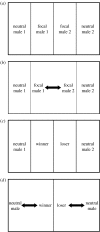Why do winners keep winning? Androgen mediation of winner but not loser effects in cichlid fish
- PMID: 19324741
- PMCID: PMC2677608
- DOI: 10.1098/rspb.2009.0132
Why do winners keep winning? Androgen mediation of winner but not loser effects in cichlid fish
Abstract
Animal conflicts are influenced by social experience such that a previous winning experience increases the probability of winning the next agonistic interaction, whereas a previous losing experience has the opposite effect. Since androgens respond to social interactions, increasing in winners and decreasing in losers, we hypothesized that socially induced transient changes in androgen levels could be a causal mediator of winner/loser effects. To test this hypothesis, we staged fights between dyads of size-matched males of the Mozambique tilapia (Oreochromis mossambicus). After the first contest, winners were treated with the anti-androgen cyproterone acetate and losers were supplemented with 11-ketotestosterone. Two hours after the end of the first fight, two contests were staged simultaneously between the winner of the first fight and a naive male and between the loser of first fight and another naive male. The majority (88%) of control winners also won the second interaction, whereas the majority of control losers (87%) lost their second fight, thus confirming the presence of winner/loser effects in this species. As predicted, the success of anti-androgen-treated winners in the second fight decreased significantly to chance levels (44%), but the success of androgenized losers (19%) did not show a significant increase. In summary, the treatment with anti-androgen blocks the winner effect, whereas androgen administration fails to reverse the loser effect, suggesting an involvement of androgens on the winner but not on the loser effect.
Figures



References
-
- Baerends G.P., Baerends Van Roon J.M. An introduction to the study of the ethology of cichlid fishes. Behaviour. 1950;((Suppl. 1)):1–242.
-
- Barata E.N., Hubbard P.C., Almeida O.G., Miranda A., Canário A.V.M. Male urine signals social rank in the Mozambique tilapia (Oreochromis mossambicus) BMC Biol. 2007;5:e54. doi:10.1186/1741-7007-5-54 - DOI - PMC - PubMed
-
- Barata E.N., Fine J.M., Hubbard P.C., Almeida O.G., Frade P., Sorensen P.W., Canário A.V. A sterol-like odorant in the urine of Mozambique tilapia males likely signals social dominance to females. J. Chem. Ecol. 2008;34:438–449. doi:10.1007/s10886-008-9458-7 - DOI - PubMed
-
- Beaugrand J.P., Payette D., Goulet C. Conflict outcome in male green swordtail fish dyads (Xiphophorus helleri): interaction of body size, prior dominance/subordination experience, and prior residency. Behaviour. 1996;133:303–319. doi:10.1163/156853996X00161 - DOI
-
- Bégin J., Beaugrand J.P., Zayan R. Selecting dominants and subordinates at conflict outcome can confound the effects of prior dominance or subordination experience. Behav. Proc. 1996;36:219–226. doi:10.1016/0376-6357(95)00031-3 - DOI - PubMed
Publication types
MeSH terms
Substances
LinkOut - more resources
Full Text Sources
Research Materials

